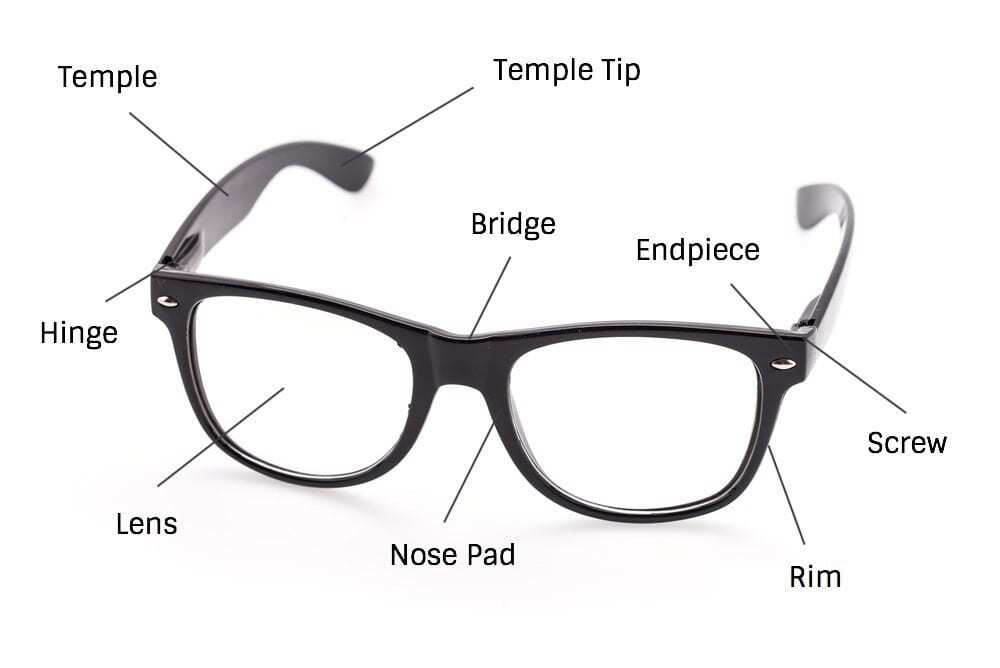Whether you’re shopping for glasses for the first time or discussing adjustments to your current pair, you may come across some unfamiliar terms, such as temples, bridge, and end piece. If you don’t understand what your optometrist or a sales assistant is referring to with these terms, don’t be afraid to ask for a quick explainer! Or maybe you’d rather learn the parts of eyeglass frames before you go shopping for new glasses? If so, review the diagram and descriptions below.
Parts of Eyeglass Frames
Bridge
The bridge is located in the center of the frames, connecting the two rims. It rests above the nose and bears most of the weight of the glasses.
Some frames have a low bridge fit, which means they’re crafted for people with low nose bridges (level with or below the pupils), wide faces, and/or high cheekbones. If you have one or more of these facial characteristics, you might find that low-bridge frames prevent the frames from sliding down your nose, pinching your nose, or resting on your cheeks.
In addition, some frames (including aviator styles) have a top bar that sits above the bridge, connecting the tops of the rims.
Endpiece
On the outer edge of each rim, you’ll find the end piece: a small part of the front frame that extends outward in order to connect the front frame to the hinges. Some glasses have elaborate, decorative endpieces.
Hinge
The hinges sit between the endpieces and the temples, and they play a pivotal role in the function of your glasses. Without them, you wouldn’t be able to close your glasses by folding the temples inward. Each hinge contains a screw.
Nose Pad
The nose pads are the round, plastic pieces under the bridge that rest on the nose. They help your glasses sit comfortably on your face.
Metal frames often include pad arms, which are adjustable pieces that attach the nose pads to the rims. They adjust to the wearer’s facial shape to provide a comfortable fit.
Lens
The lenses are what allow you to see clearly. They’re commonly made of clear plastic, high-index plastic, or polycarbonate, and a variety of styles and features are available, including bifocals, progressives, and Transitions®.
Rims
The rims give the glasses form and character and hold the lenses in place. They can be thick or thin, simple or elaborate, understated or eye-catching, and any color imaginable. Some glasses are rimless, which means they lack a frame front and have a minimalist, barely-there appeal. On rimless frames, the bridge and temples connect directly to the lenses.
Screw
Tiny screws, typically made of metal or plastic, are inserted into the hinge to connect the temples to the end pieces.
Temples
The temples are the arms on each side of the frame, extending from the front of the frame to behind your ears.
Temple Tip
Sometimes referred to as earpieces, the temple tips are located at the ends of the temples. They are the portion that rests behind the ears, providing extra comfort (especially on glasses with metal frames).
_____
Although most frames contain all of these parts, you’ll occasionally see exceptions. For example, some eyeglasses lack rims and others have a bridge and pad arms. If you have any questions about the parts of eyeglass frames and you live near southwest Missouri, stop by Heffington’s. Since 1975, the Heffington family has been assisting the Springfield community with top-quality eye care and affordable eyeglasses and contacts. To learn more about our products and services, please get in touch with us online, send an e-mail to asktheexperts@heffingtons.com, or give us a call at 417-869-3937 (Optiland location) or 417-882-3937 (House of Vision location).

